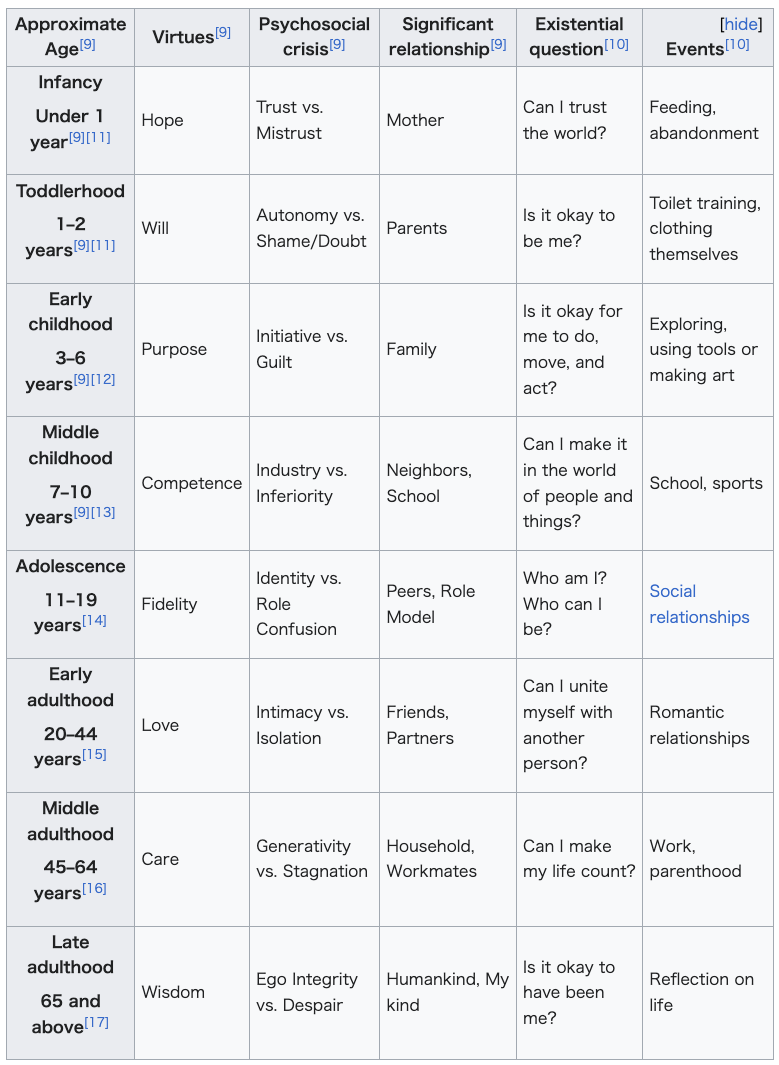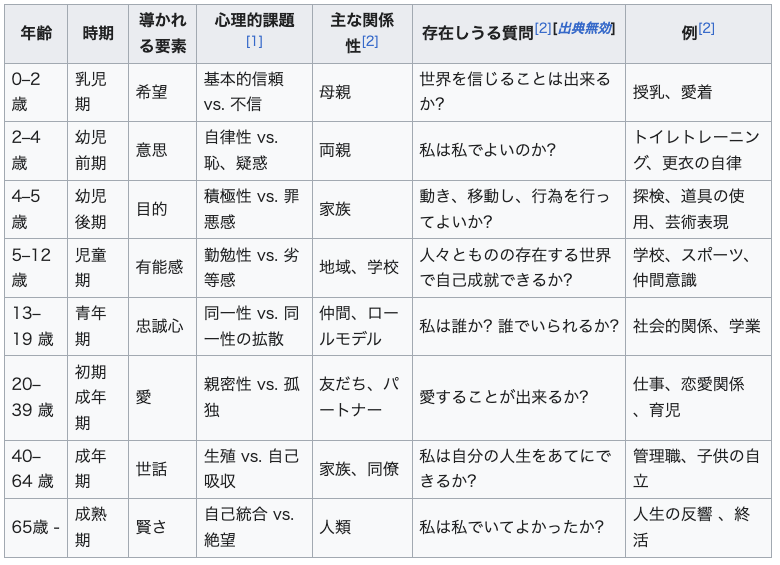
アイデンティティの危機
Identity crisis

☆ 心理学において、アイデンティティ・クライシス(アイデンティティの危機)とは、人生の8つの段階における葛藤の解決を伴うアイデンティティ発達に関する 段階理論である。この用語は、ドイツの心理学者エリク・エリクソンによって作られた。 アイデンティティ・クライシスが起こりうる心理社会的発達段階は、アイデンティティの結束対役割の混乱と呼ばれる。この段階では、思春期の若者は身体的成 長、性的成熟、そして自分自身についての考えと他人が自分についてどう考えているかについての考えを統合することに直面する。 したがって、彼らは自己イメージを形成し、自我同一性の危機を解決するという課題に耐える。危機をうまく解決できるかどうかは、信頼、自律、率先力といっ た問題を中心とする、それまでの発達段階における進歩の度合いに依存する。エリクソンのアイデンティティへの関心は、幼少期に始まった。アシュケナジム系 ユダヤ人として生まれた彼は、自分は部外者であると感じていた。後に、カリフォルニア州北部のユロック族やサウスダコタ州のスー族の文化生活を研究したこ とが、アイデンティティの発達とアイデンティティ・クライシスに関する彼の考えを体系化するのに役立った。エリクソンは、アイデンティティ・クライシスを 経験している人々は混乱状態にあると述べている。
| In psychology,
identity crisis is a stage theory of identity development which
involves the resolution of a conflict over eight stages of life.[1][2]
The term was coined by German psychologist Erik Erikson. The stage of psychosocial development in which identity crisis may occur is called identity cohesion vs. role confusion. During this stage, adolescents are faced with physical growth, sexual maturity, and integrating ideas of themselves and about what others think of them.[3] They therefore form their self-image and endure the task of resolving the crisis of their ego identity. Successful resolution of the crisis depends on one's progress through previous developmental stages, centering on issues such as trust, autonomy, and initiative.[3] Erikson's interest in identity began in childhood. Born Ashkenazic Jewish, he felt that he was an outsider. His later studies of cultural life among the Yurok of northern California and the Sioux of South Dakota helped formalize his ideas about identity development and identity crisis. Erikson described those going through an identity crisis as exhibiting confusion.[2] |
心理学において、アイデンティティ・クライシスとは、人生の8つの段階
における葛藤の解決を伴うアイデンティティ発達に関する段階理論である。[1][2]
この用語は、ドイツの心理学者エリク・エリクソンによって作られた。 アイデンティティ・クライシスが起こりうる心理社会的発達段階は、アイデンティティの結束対役割の混乱と呼ばれる。この段階では、思春期の若者は身体的成 長、性的成熟、そして自分自身についての考えと他人が自分についてどう考えているかについての考えを統合することに直面する。[3] したがって、彼らは自己イメージを形成し、自我同一性の危機を解決するという課題に耐える。危機をうまく解決できるかどうかは、信頼、自律、率先力といっ た問題を中心とする、それまでの発達段階における進歩の度合いに依存する。[3] エリクソンのアイデンティティへの関心は、幼少期に始まった。アシュケナジム系ユダヤ人として生まれた彼は、自分は部外者であると感じていた。後に、カリ フォルニア州北部のユロック族やサウスダコタ州のスー族の文化生活を研究したことが、アイデンティティの発達とアイデンティティ・クライシスに関する彼の 考えを体系化するのに役立った。エリクソンは、アイデンティティ・クライシスを経験している人々は混乱状態にあると述べている。[2] |
| Concept Main article: Erikson's stages of psychosocial development Adolescents may withdraw from normal life, not taking action or acting as they usually would at work, in their marriage or at school, or be unable to make defining choices about the future. They may even turn to negative activities, such as crime or drugs since from their point of view having a negative identity could be more acceptable than none at all.[2] On the other side of the spectrum, those who emerge from the adolescent stage of personality development with a strong sense of identity are well equipped to face adulthood with confidence and certainty. Erikson studied eight stages that made up his theory. To him, ego identity is a key concept to understanding what identity is, and it plays a large role in the conscious mind that includes fantasies, feelings, memories, perceptions, self-awareness, sensations, and thoughts; Each contributing a sense to self that is developed through social interaction.[4] He felt that peers have a strong impact on the development of ego identity during adolescence. He believed that association with negative groups such as cults or fanatics can actually "redistrict" the developing ego during this fragile time. The basic strength that Erikson argued should be developed during adolescence is fidelity, which only emerges from a cohesive ego identity. Fidelity encompasses sincerity, genuineness and a sense of duty in relationships with other people.[2] Erikson defined the crisis as an argument between identity and confusion. Confusion lies between the younger generation, teenagers, and during adolescence he states that they "need to develop a sense of self and personal identity". If they do not develop this sense, they will be insecure and lose themselves, lacking confidence and certainty in adult life.[5] He described identity as "a subjective sense as well as an observable quality of personal sameness and continuity, paired with some belief in the sameness and continuity of some shared world image. As a quality of unself-conscious living, this can be gloriously obvious in a young person who has found himself as he has found his commonality. In him we see emerge a unique unification of what is irreversibly given—that is, body type and temperament, giftedness and vulnerability, infantile models and acquired ideals—with the open choices provided in available roles, occupational possibilities, values offered, mentors met, friendships made, and first sexual encounters."[6] |
概念 詳細は「エリクソンの心理社会的発達段階」を参照 思春期の人々は、職場や家庭、学校などにおいて、通常であれば行う行動や振る舞いを取らず、通常の生活から身を引いてしまうことがある。あるいは、将来に ついて決定的な選択を行うことができないこともある。彼らにとって、否定的なアイデンティティを持つことは、まったくアイデンティティを持たないよりは受 け入れられる可能性があるため、犯罪や薬物などの否定的な活動に走る可能性もある。[2] 一方、アイデンティティを強く確立して思春期を終える人は、自信と確信を持って成人期を迎える準備ができている。 エリクソンは、彼の理論を構成する8つの段階を研究した。彼にとって自我同一性は、アイデンティティとは何かを理解するための重要な概念であり、それは空 想、感情、記憶、知覚、自己認識、感覚、思考などを含む意識的な精神に大きな役割を果たしている。それぞれが社会的な相互作用を通じて形成される自己感覚 に貢献している。[4] 彼は、思春期における自我同一性の発達には仲間が強い影響を与えると感じていた。彼は、カルトや狂信者などのネガティブなグループとの関わりが、この不安 定な時期に成長中の自我を「再区分」してしまう可能性があると信じていた。 エリクソンが思春期に育むべきだと主張した基本的な強さは「誠実さ」であり、それはまとまりのある自我からしか生まれない。誠実さには、他人との関係にお ける誠意、真実性、義務感が含まれる。混乱は、若い世代、つまりティーンエイジャーの間に起こり、思春期には「自己と個人のアイデンティティに対する感覚 を育む必要がある」と彼は述べている。この感覚を育むことができない場合、彼らは自信を失い、自分を見失い、成人後の生活において自信と確信を欠くことに なる。[5] 彼はアイデンティティを「主観的な感覚であり、また、個人的な同一性と継続性という観察可能な性質であり、共有された世界像の同一性と継続性に対する信念 と結びついている」と説明している。無意識に生きるという性質として、自分自身を見出し、共通点を見出した若者には、このことがはっきりと現れる。 つまり、体質や気質、才能や脆弱性、幼少期のモデルや後天的な理想など、不可逆的に与えられたものに、役割、職業の可能性、価値観、指導者、友人関係、そ して初めての性的体験など、選択肢として与えられた開かれた選択肢が組み合わさり、独特な統一性が生まれるのである。」[6] |
| Marcian theory James Marcia's research on identity statuses of adolescents also applies to Erikson's framework of identity crises in adolescents. Identity foreclosure is an identity status which Marcia claimed is an identity developed by an individual without much choice. "The foreclosure status is when a commitment is made without exploring alternatives. Often these commitments are based on parental ideas and beliefs that are accepted without question".[citation needed] Identity foreclosure can contribute to identity crises in adolescents when the "security blanket" of their assumed identity is removed. These "foreclosed individuals often go into crisis, not knowing what to do without being able to rely on the norms, rules, and situations to which they have been accustomed".[7] An example of this would be a son of a farmer who learns that his father is selling the farm, and whose identity as an heir to a farm and the lifestyle and identity of a farmer has been disrupted by that news. Identity diffusion is a Marcian identity status that can lead to identity crises in adolescents. Identity diffusion can be described as "the apathetic state that represents the relative lack of both exploration and commitment".[7] Identity diffusion can overlap with diagnoses such as schizophrenia and depression, and can best be described as a lack of identity structure. An example of an identity crisis emerging from this status is an adolescent who becomes reclusive after his identity as a star athlete is destroyed by a serious injury. Identity moratorium is the status that Marcia theorizes lasts the longest in individuals, is the most volatile, and can be best described as "the active exploration of alternatives".[citation needed] Individuals experiencing identity moratorium can be very open-minded and thoughtful but also in crisis over their identity.[8] An example of this would be a college student who lacks conviction in their future after changing majors multiple times but still cannot seem to find their passion. Identity achievement is the resolution to many identity crises. Identity achievement occurs when the adolescent has explored and committed to important aspects of their identity.[9][10][full citation needed] |
マーシアンの理論 ジェームズ・マーシアによる青年期のアイデンティティ・ステータスに関する研究は、青年期のアイデンティティ・クライシスに関するエリクソンの枠組みにも 当てはまる。 アイデンティティの喪失は、マーシャが主張するアイデンティティの状態であり、個人が選択の余地なく形成したアイデンティティである。「喪失の状態とは、 代替案を検討することなく、あるコミットメントが為された場合である。これらのコミットメントは、親の考えや信念に基づいており、疑問を持たずに受け入れ られることが多い」[要出典] アイデンティティの喪失は、想定されたアイデンティティの「安全な毛布」が取り除かれた場合に、思春期のアイデンティティの危機の一因となる可能性があ る。こうした「追い込まれた人々は、慣れ親しんできた規範やルール、状況に頼ることができず、何をしたらよいのかもわからないまま、しばしば危機に陥る」 のである。[7] その例としては、農家の息子が、父親が農場を売却することを知り、農場を継ぐ者としてのアイデンティティや農場主としてのライフスタイル、農家としてのア イデンティティがその知らせによって崩壊してしまうような場合が挙げられる。 アイデンティティ拡散は、青年期のアイデンティティ危機につながるマルシアのアイデンティティ状態である。アイデンティティ拡散は、「探求と献身の両方が 相対的に欠如している無気力な状態」と表現できる。[7] アイデンティティ拡散は、統合失調症やうつ病などの診断と重複することがあり、アイデンティティ構造の欠如と表現するのが最も適切である。この状態から生 じるアイデンティティ危機の例としては、深刻な怪我によりスター選手としてのアイデンティティが崩壊し、内向的になる青年が挙げられる。 アイデンティティのモラトリアムとは、マーシャが理論化した中で最も長く続く状態であり、最も不安定で、「代替案の積極的な模索」と表現するのが最もふさ わしい状態である。[要出典] アイデンティティのモラトリアムを経験している個人は、非常に心が広く思慮深い一方で、アイデンティティの危機に陥っている場合もある。[8] その例としては、専攻を何度も変えた結果、将来に対する確信が持てず、まだ情熱を見つけられない大学生などが挙げられる。 アイデンティティの達成は、多くのアイデンティティの危機に対する解決策である。アイデンティティの達成は、思春期の若者が自分自身のアイデンティティの 重要な側面を探求し、それに専念したときに起こる。[9][10][要出典] |
| Erikson's stages of psychosocial
development Existential crisis |
エリクソンの心理社会的発達段階 実存の危機 |
 |
 |
| https://en.wikipedia.org/wiki/Identity_crisis |
|
リ ンク
文 献
そ の他の情報
Copyleft, CC, Mitzub'ixi Quq Chi'j, 1996-2099
☆
 ☆
☆